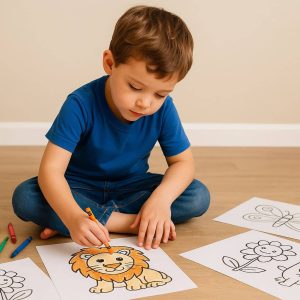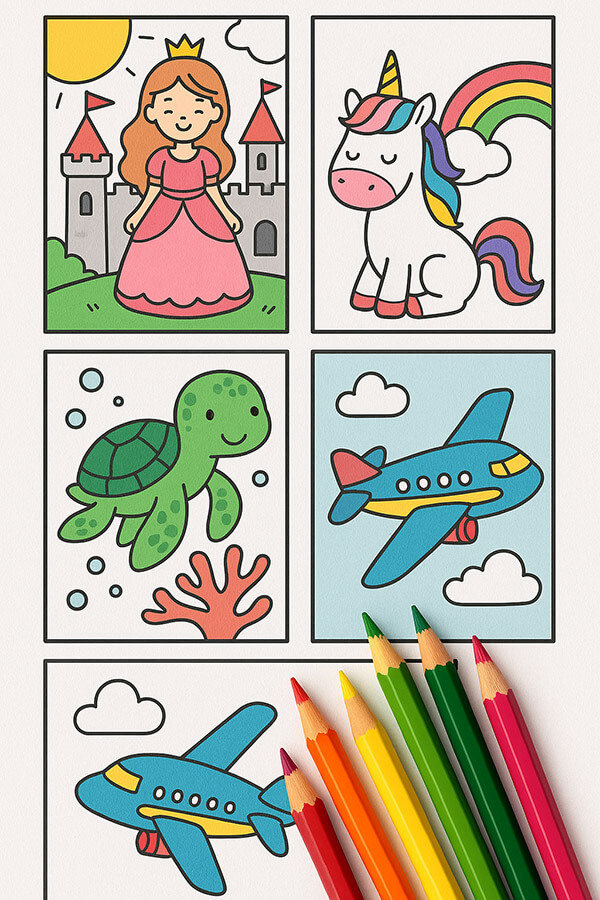Coloring Pages for Kids – A Fun and Educational Activity
Coloring pages for kids are a relaxing, fun, and educational activity suitable for almost any age. Beyond offering children a creative way to express themselves, coloring also helps develop essential skills such as:
Fine motor skills
Color and shape recognition
Imagination and creativity
Focus and concentration
For the best experience, it’s important to choose coloring pages that match your child’s developmental stage. This ensures that coloring is not only enjoyable but also meaningful and beneficial for their growth.
In this guide, we explore the most recommended coloring page themes for kids by age, along with inspiring examples and ideas for incorporating coloring into daily routines.
Ages 2–3: Basic Shapes and Familiar Animals
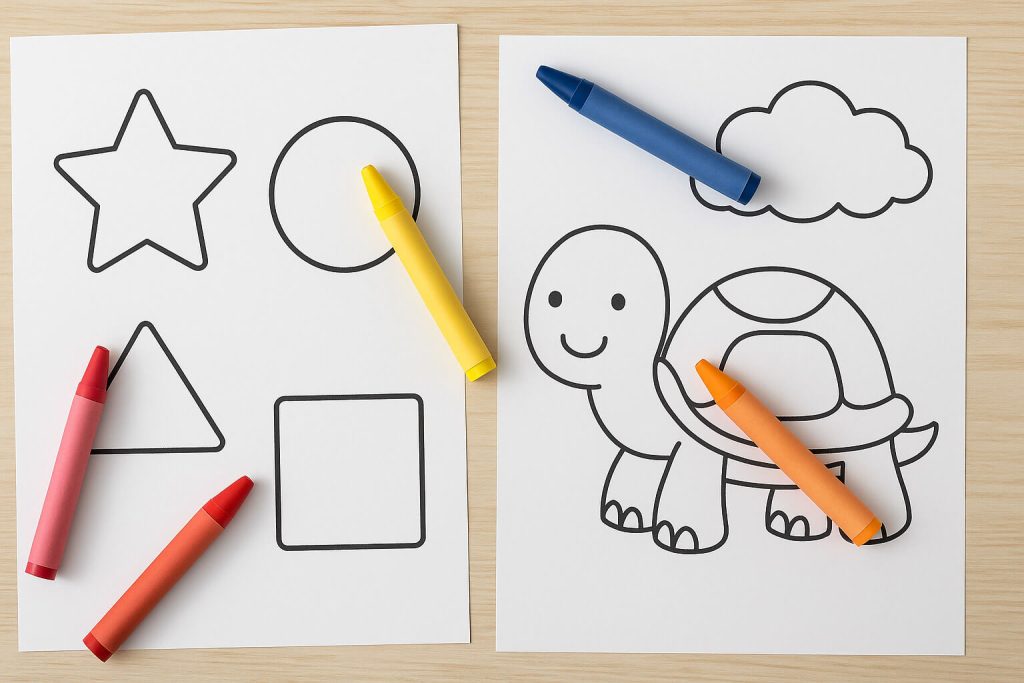
At ages two to three, children are in the early stages of developing fine motor skills and exploring the world around them. They are naturally curious, love experimenting with colors, and enjoy short activities that give them a quick sense of achievement. Age-appropriate coloring pages can turn into a relaxing, fun, and educational activity that supports their growth.
🎨 Recommended Coloring Page Themes for Ages 2–3:
Large and Simple Shapes – Circles, squares, triangles, hearts, and stars.
Helps toddlers recognize and differentiate between basic shapes.
Bigger shapes are easier to color, creating quick successes that motivate them to keep going.
Everyday Animals – Cows, sheep, chickens, dogs, and cats.
Encourages early animal recognition and name learning.
You can add a short explanation about each animal while coloring to enrich vocabulary.
Big, Clear Fruits and Vegetables – Apples, bananas, carrots, and watermelons.
Teaches children to identify familiar foods and connect them to daily meals.
Using natural colors (green, red, orange) reinforces visual understanding.
Simple Everyday Objects – A ball, a bottle, a table, or a bed.
Coloring familiar objects strengthens their connection to the real world.
Helps build confidence and provides a positive sense of accomplishment.
These early coloring experiences are a fun way to combine creativity and learning, laying the foundation for essential cognitive and motor skills.
Educational Benefits of Coloring Pages for Ages 2–3
Coloring pages for toddlers are more than just a fun activity—they provide valuable learning experiences that support early development:
Fine Motor Skill Development – Holding crayons and coloring within thick lines helps strengthen hand and finger muscles.
Color Recognition – Toddlers learn to identify colors, experiment with shades, and match colors to shapes.
Real-World Connection – Coloring familiar objects like fruits, animals, or toys reinforces the link between drawings and daily life.
Sense of Achievement – Simple coloring pages allow children to finish tasks on their own, boosting confidence and independence.
💡 Tips for Parents
Choose Pages with Bold, Clear Outlines – Thick lines make it easier for toddlers to succeed, even if they color outside the lines.
Talk While Coloring – Describe shapes, animals, or objects as your child colors to enhance language development.
Encourage Creative Color Choices – Let your child color a pink sun or a green cat if they wish; it strengthens creativity and imagination.
Keep Printable Coloring Pages Handy – Having a small booklet of age-appropriate pages ready makes it easy to engage your child during quiet moments or free play.
👉 Download free printable coloring pages for ages 2–3 here to always have engaging activities at your fingertips.
Ages 4–5: Animals, Transportation, and Everyday Scenes
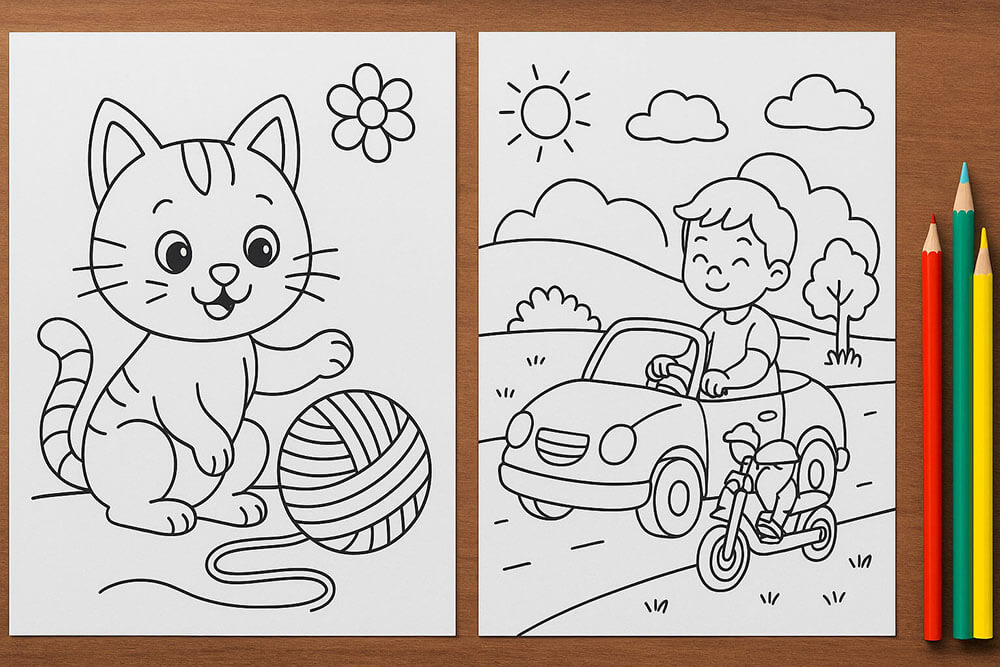
At ages four to five, children have better fine motor control, can focus for longer periods, and start showing personal interests in specific topics. Coloring pages for this age group should balance learning, fun, and creative freedom.
🎨 Recommended Coloring Page Themes for Ages 4–5:
Variety of Animals – Horses, giraffes, fish, dolphins, and lions.
Introduces children to different worlds like farms, safaris, and the ocean.
Helps them recognize animal shapes and learn unique traits of each species.
Nature Elements – Trees, flowers, clouds, mountains, and rivers.
Encourages a connection between art and the natural environment.
Seasonal coloring (like snow in winter or flowers in spring) makes learning fun.
Transportation and Advanced Everyday Objects – Cars, trains, bicycles, and boats.
Sparks curiosity about how vehicles and objects function in daily life.
Supports understanding of the child’s surroundings and environment.
Coloring Pages with Medium Details
Add simple patterns like flowers on bushes, spots on animals, or windows on houses.
Detailed coloring improves concentration and hand-eye coordination.
📌 Educational Benefits of Coloring Pages for Ages 4–5
Improves Focus and Patience – Kids learn to sit longer and complete a drawing from start to finish.
Boosts Imagination – Creative color choices and adding small details enhance storytelling skills.
Expands General Knowledge – Children discover new animals, plants, vehicles, and environments while coloring.
Enhances Motor Control – Coloring inside medium-sized shapes strengthens the skills needed for early writing.
💡 Tips for Parents
Encourage Storytelling – Ask your child to create a story while coloring, like what the giraffe is doing or where the train is going.
Combine Coloring with Real Experiences – After coloring butterflies, go outside to spot real ones in the garden.
Create a Seasonal Coloring Collection – Summer for ocean and fish pages, autumn for leaves and golden landscapes.
👉 Download your free printable coloring pages for ages 4–5 here and always have engaging activities ready for your child.
Ages 6–7: Story Characters, Nature, and Detailed Scenes
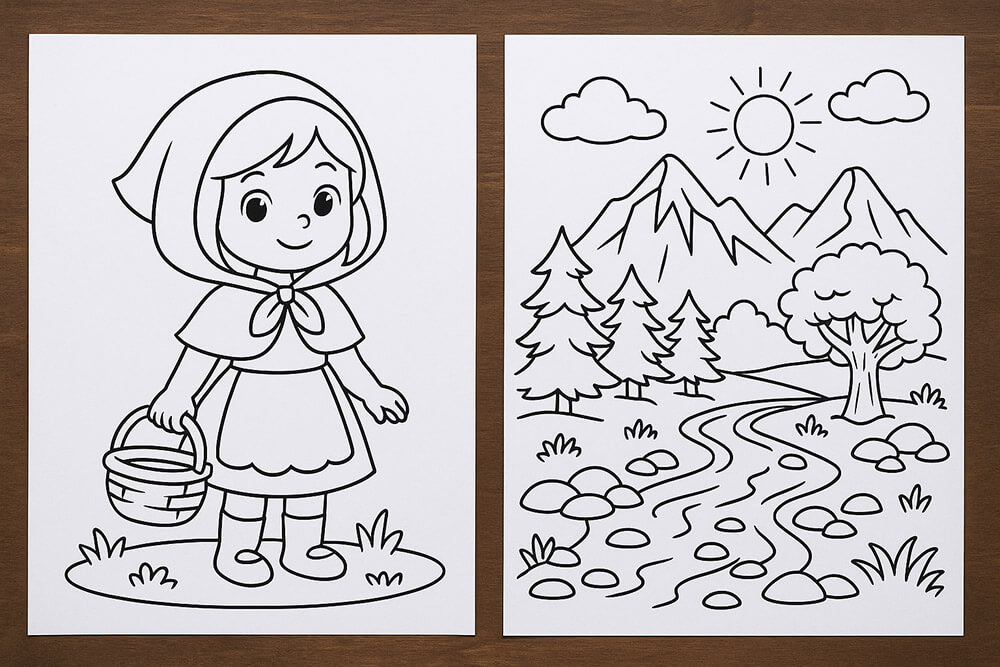
By ages six to seven, children have stronger control over coloring tools, can focus for longer periods, and enjoy new creative challenges. Coloring pages with more complex details and diverse themes allow them to express higher levels of creativity while learning through play.
🎨 Recommended Coloring Page Themes for Ages 6–7:
Exotic Animals and Their Habitats
Lions, elephants, dolphins, crocodiles, and tropical birds expand children’s knowledge of the animal kingdom.
Adding backgrounds like savannas, forests, or oceans teaches them about different living environments.
Real-Life Scenes
Parks, gardens, shops, streets, and public transportation settings help kids recognize familiar situations.
Coloring characters performing daily activities—like playing, riding a bike, or reading—builds a natural connection to real life.
Fantasy and Adventure Worlds
Castles, dragons, knights, fairies, and unicorns spark the imagination and inspire original storytelling.
At this age, children love experimenting with unique colors to bring imaginary worlds to life.
Coloring Pages with Visual Challenges
Drawings with small details, geometric patterns, or repeated designs encourage patience and precision.
This type of coloring prepares children for neat handwriting and fine tasks like cutting and gluing.
📌 Educational Benefits of Coloring Pages for Ages 6–7
Enhances Focus and Attention to Detail – Complex pages require sustained concentration over longer periods.
Boosts Imagination and Storytelling Skills – Children naturally create stories around their drawings and use more creative color choices.
Prepares for School Tasks – Precise coloring improves pencil control and supports future handwriting skills.
Expands General Knowledge – Exposure to diverse topics, from animals to natural environments, enriches learning in a fun, interactive way.
Ages 8–9: Educational and Creativity-Challenging Coloring Pages
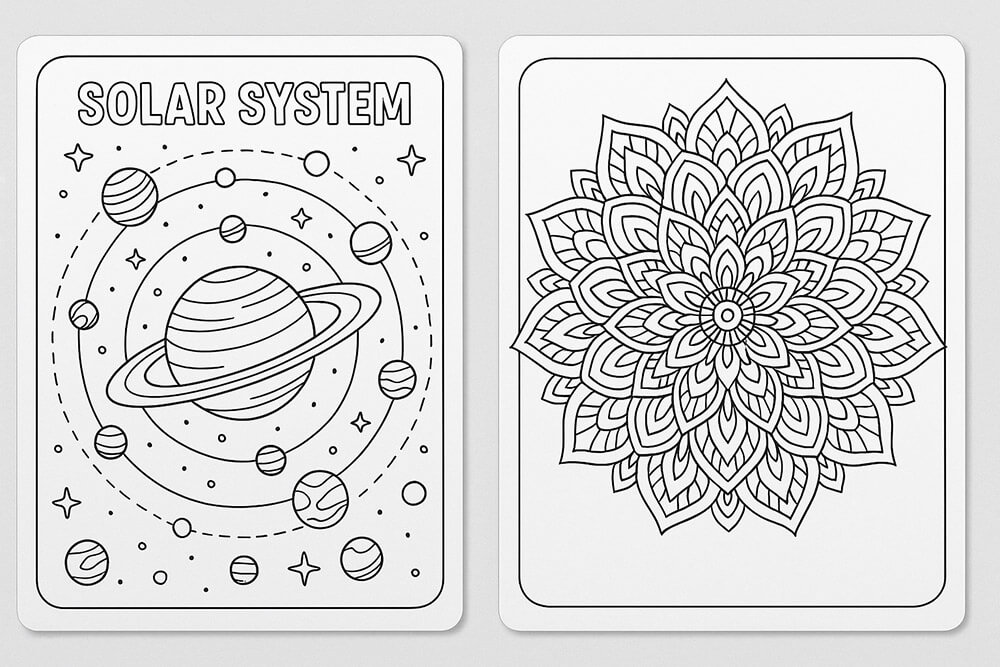
By ages eight to nine, children have strong control of coloring and writing tools and can handle more detailed and challenging illustrations. At this stage, coloring pages become a tool for developing creativity, focus, and a deeper understanding of the world around them.
🎨 Recommended Coloring Page Themes for Ages 8–9:
Wild Animals and Nature Exploration
Bears, wolves, owls, tigers, and other forest creatures encourage kids to explore wildlife in depth.
Adding natural backgrounds like mountains, lakes, and forests enhances ecological awareness and knowledge of different habitats.
Detailed Buildings and Scenic Landscapes
Ancient castles, bridges, small towns, or picturesque villages turn coloring into a calming and precise experience.
Filling in windows, rooftops, trees, and small elements strengthens patience and attention to detail.
Complex Patterns and Kids’ Mandalas
At this age, children enjoy repetitive shapes and intricate designs that resemble mandalas.
Coloring patterns like these improves concentration, sparks creativity, and promotes relaxation.
Imaginative and Fantasy Worlds
Dragons, friendly monsters, wizards, and mythical creatures give children complete creative freedom.
They can invent unique stories for their characters and use unexpected color combinations to express their imagination.
📌 Educational Benefits of Coloring Pages for Ages 8–9
Improves Long-Term Focus – Detailed pages require patience and careful attention over extended periods.
Develops Creative and Independent Thinking – Children experiment with color choices and original ideas without relying on preset examples.
Enhances Visual Skills – Understanding proportions, spatial structure, and small elements also supports learning in art and geometry.
Reduces Stress and Promotes Calm – Coloring becomes a relaxing activity that helps kids unwind after school and release tension.
Ages 10 and Up: Advanced Coloring Pages and Creative Art
By the age of ten and beyond, coloring takes on an entirely new dimension. It evolves from a basic learning tool into a full artistic activity that promotes creativity, patience, and persistence. Children at this stage can tackle highly detailed illustrations and enjoy the experience of independent creation.
🎨 Recommended Coloring Page Themes for Ages 10+:
Mandalas and Complex Art Patterns
Large mandalas and symmetrical designs strengthen focus and create a calming, almost meditative experience.
Coloring intricate details encourages patience and fine motor control.
Detailed Nature and Scenic Landscapes
Mountains, forests, waterfalls, lakes, and seaside views help children practice precision and use a wide range of colors.
Adding small elements like birds, flowers, or leaves enhances attention to detail and offers an artistic challenge.
Art-Inspired Coloring Pages
Designs inspired by stained glass, Art Nouveau, geometric patterns, or museum-style illustrations introduce kids to new artistic worlds.
These pages enrich art knowledge and aesthetic appreciation while fostering creativity.
Advanced Fantasy Worlds
Older kids enjoy challenging themselves with mythical creatures, intricate fantasy worlds, and original characters they invent while coloring.
Using unexpected color combinations and shading effects allows them to create truly unique works of art.
📌 Educational Benefits of Coloring Pages for Ages 10 and Up
Enhances Persistence and Self-Discipline – Complex drawings require time, patience, and determination to complete.
Develops Advanced Artistic Skills – Working with shading, textures, and gradients improves overall drawing and coloring techniques.
Provides Stress Relief and Emotional Balance – Coloring serves as a healthy outlet for emotions and promotes relaxation.
Encourages Cultural and Artistic Enrichment – Exposure to complex themes from art and nature nurtures curiosity and broadens knowledge.
How to Choose the Right Coloring Pages for Every Age
Coloring pages are not just a solo activity for kids at their desks. When coloring becomes a family or group activity, it gains extra value—strengthening emotional bonds, creating shared memories, and turning learning into an engaging and joyful experience.
🖌 Benefits of Group Coloring
Strengthening Family Bonds
Sitting together for a coloring session creates moments of calm, natural conversation, and cooperation.
Each family member can choose a picture or section to color, transforming the activity into a shared creative project.
Encouraging Teamwork and Friendship
When multiple children color together, they learn to share materials, collaborate, and appreciate each other’s work.
Group coloring during classroom activities or birthday parties builds a fun and inclusive environment.
Improving Communication Skills
Kids naturally talk about the colors they chose, the characters they are coloring, and the stories they imagine.
This lighthearted interaction boosts self-confidence and encourages open expression.
🎨 Group Coloring Activity Ideas
Relaxing Family Evening
Dedicate 30 minutes after a busy day to coloring together in the living room with soft background music.
Creative Birthday Party Activity
Kids love hands-on activities at parties! Prepare themed coloring pages—animals, space, or nature—to match the celebration.
Collaborative Wall Art Project
Assign each child a part of a larger image. When completed, assemble all pieces into a beautiful collage to display on the wall.
Interactive Learning Session
Turn educational topics, like seasons or safari animals, into a group coloring experience, making learning fun and visual.
Coloring Pages as an Educational Activity for All Ages
To maximize both fun and developmental value, it is important to choose the right coloring pages and use them wisely. With thoughtful selection, coloring transforms from a simple hobby into a powerful educational and creative tool.
🖌 How to Choose Quality Coloring Pages
Match the Pages to the Child’s Age
Ages 2–3: Large, simple illustrations that are easy to fill.
Ages 4–6: Medium-detailed drawings that encourage focus and fine motor skills.
Ages 7+: More complex pages, including mandalas, landscapes, and fantasy worlds.
Offer a Variety of Themes
Include animals, nature, transportation, space, and familiar cartoon characters to maintain interest.
Rotate themes weekly to prevent boredom and spark curiosity.
Check Print Quality
High-quality printing ensures a pleasant coloring experience, especially with markers or watercolor.
Use thicker paper if you plan to keep the finished artworks.
🎨 Tips to Turn Coloring Into a Rich Learning Experience
Create a Daily Routine – Add 10–15 minutes of coloring as a relaxing daily activity.
Add Creative Elements – Use stickers, glitter, or cut out finished drawings to create collages.
Combine with Natural Learning – If your child colors forest animals, encourage them to learn about each animal in books or online.
Share and Display the Artwork – Hang finished pages on the wall or send photos to family.
This boosts motivation and encourages ongoing creativity.
Why Coloring Pages Are More Than Just Fun
Coloring pages are far more than a casual activity—they:
Strengthen fine motor skills and hand-eye coordination.
Support cognitive development through focus and detail recognition.
Encourage emotional expression and stress relief.
Provide creative exploration for all age groups.
When parents integrate coloring into family routines, they discover it brings calm, bonding moments, and nurtures patience and imagination in children. From toddlers to school-age kids, coloring pages offer hours of creative, educational engagement.
💡 Tip: Keep a ready-to-print collection of coloring pages in various themes and difficulty levels. Whenever boredom strikes or during school breaks, you’ll have the perfect solution for fun, relaxation, and learning.
👉 Click here to download high-quality coloring pages for all ages


